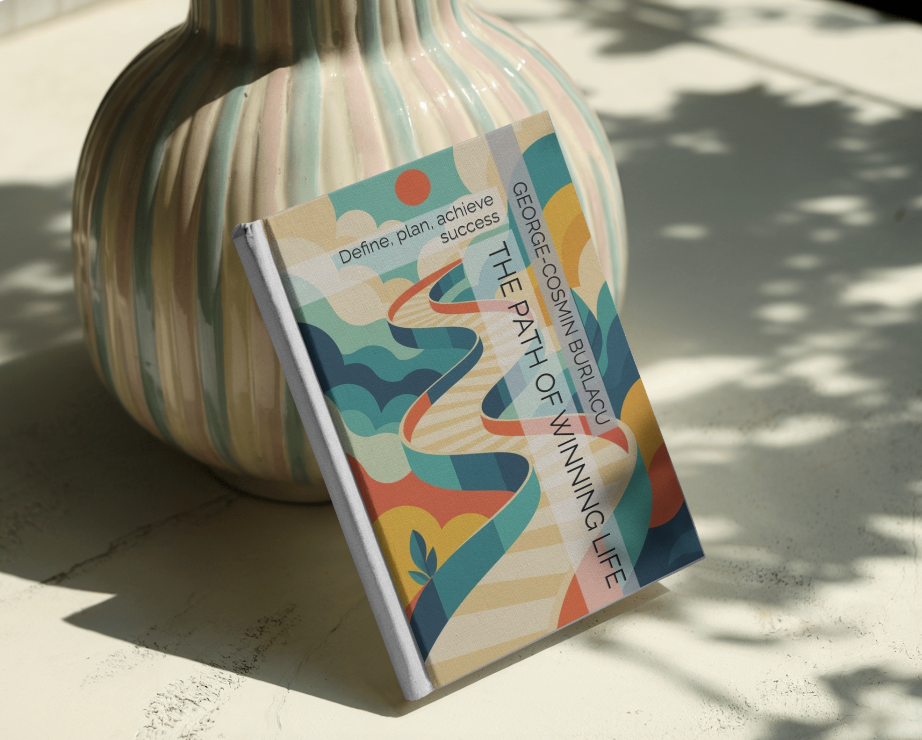The path of winning life: Define, plan, achieve success
THE PATH OF WINNING LIFE by George Cosmin Burlacu stands as a transformative guide that explores the essence of personal triumph through a blend of psychological insights, philosophical wisdom, and practical strategies. This book invites readers to redefine what victory means in their lives, moving beyond societal expectations to discover a path of authentic fulfillment. George Cosmin Burlacu, the author, crafts a narrative that weaves together concepts of mental programming, growth through adversity, the hero’s journey, and relational dynamics, offering a roadmap for those seeking to break free from limitations and embrace a life of purpose and resilience.
At the heart of the book is the idea of defining personal success. Burlacu argues that many people chase goals imposed by culture, family, or media, leading to a sense of emptiness even when those goals are achieved. The book encourages readers to engage in introspection to uncover what truly brings joy and meaning. Through probing questions and reflective exercises, it helps build a framework aligned with individual values, emphasizing that success is not about accumulation but about inner harmony and motivation. This section sets the tone for the rest of the book, challenging readers to question conditioned thinking and craft a unique vision that sustains long term satisfaction. The book then delves into the concept of mental programming, explaining how cognitive and emotional frameworks shape perceptions and behaviors. Burlacu describes programming as an internal software formed by experiences, social learning, and repetition, drawing from behaviorism and cognitive psychology.
Readers learn to identify these patterns through awareness and reflection, using techniques like journaling to challenge distorted beliefs. The book provides steps for deprogramming, such as interrupting negative thought loops with mindfulness, and reprogramming with affirmations and visualization to align with personal goals. This process is presented as malleable, supported by neuroplasticity, allowing individuals to shift from reactive living to deliberate mastery.
Burlacu explores how people grow, portraying development as a cyclical process involving hardships, the hero’s journey, and periods of profound crisis. Hardships are framed as catalysts for post traumatic growth, reframing adversity as opportunities for empathy and purpose. The hero’s journey, inspired by Joseph Campbell, maps life as a quest with stages of call, trials, ordeal, and return, where challenges integrate wisdom into everyday life. The dark night of the soul is depicted as an existential purge, stripping illusions to reveal authenticity, with examples from historical figures showing how such periods lead to renewed meaning. The growth cycle synthesizes these, describing phases of awakening, confrontation, refinement, and transcendence, incorporating Stoic philosophy to embrace trials as fuel for virtue and greatness.
Relationships play a key role in the book, with sections on rivals and allies. Rivals are seen as mirrors that sharpen ambition and reveal weaknesses, providing lessons in humility, social intelligence, and innovation. Burlacu discusses how to deal with rivals by reframing competition as mutual elevation, using emotional regulation to transform envy into motivation. Allies, on the other hand, are attracted through authenticity, reciprocity, and shared values, with strategies for building networks that support growth. The book advises positioning oneself in aligned environments, leading with generosity, and sustaining bonds through communication and gratitude, turning relationships into a force for collective success. The final section, the life winner’s toolbox, equips readers with practical instruments like self awareness, goal setting, emotional regulation, growth mindset, relational building, productivity methods, physical vitality practices, continuous learning, and gratitude. Each tool is explained with steps for implementation, tied to the book’s themes to help readers apply insights in daily life.
Define, plan, achieve success
This book equips readers with tools to craft a unique definition of success, guiding introspection to identify what brings genuine joy and purpose. It helps escape external pressures like wealth or status, using reflective exercises to align with personal values for greater satisfaction and motivation. It teaches reprogramming the mind for resilience, distinguishing limiting beliefs from empowering habits to turn negative reactions into deliberate actions that support goals.
Through examples and philosophy, it reframes adversity as a catalyst for growth, building emotional fortitude and empathy to reduce stress during tough times. Inspired by mythic structures, it maps life’s challenges as a quest, boosting confidence and direction in pursuing aspirations. The book offers advice on attracting supportive networks, using emotional intelligence to create collaborations that amplify efforts and reduce isolation. It provides versatile tools for goal setting, emotional regulation, and continuous learning to maintain productivity and vitality for long term fulfillment.
Burlacu emphasizes that personal success starts with questioning societal norms. Readers are encouraged to set aside time for reflection, asking what activities bring energy rather than drain it, and to note patterns in a journal to discern true desires. The book warns against seeking approval, using examples like entrepreneurs who pursued passions against odds, finding fulfillment beyond metrics. It advises building a flexible framework with pillars like relationships or creativity, described in vivid terms to make them graspable, and adjusting as life changes. On programming, the book details how scripts form from early influences, using neuroscientific terms to explain pathway strengthening. Good programming is flexible, allowing updates, while bad is rigid, leading to rumination. Deprogramming involves observing thoughts without judgment, using breath to interrupt cycles, and reprogramming with sensory visualization to embody new responses. It suggests rituals like morning intentions to anchor changes, extending to language shifts for empowerment.
Growth is presented as nonlinear, with hardships as refiners, using stories of survival to show post traumatic growth. The hero’s journey is broken into stages, with strategies for each, like seeking guidance during resistance. The dark night is described as a purification, with techniques like somatic practices to process emotions. For relationships, the book advises embodying qualities to attract allies, using reciprocity to build bonds, and reframing rivals as teachers through analysis of their methods for insights. The toolbox integrates these, with self awareness through prompts, goal setting with visualization, emotional tools like reframing, mindset shifts, relational strategies, productivity matrices, wellness habits, learning resources, and gratitude practices.
Through this structure, Burlacu delivers a guide that empowers readers to author their own victories.
The book continues by expanding on each chapter, providing detailed explanations and actionable steps. In defining success, it offers exercises to visualize ideal days and identify mismatches with current paths, emphasizing emotional mapping to ensure aims resonate deeply. For programming, it includes examples of counter narratives and physical practices to ground changes, like movement to release tension. The growth section details the cycle with Stoic exercises for embracing hardships, such as premeditation to prepare for challenges, and examples from history to illustrate transcendence.
Relational dynamics are explored with strategies for converting rivals into allies through common ground and gratitude, and sustaining friendships with communication tools.
The toolbox is presented as adaptable, with tips for customizing to personal needs. This comprehensive approach makes the book a resource for lifelong application, blending theory with practice for real transformation. Burlacu George Cosmin writes with a tone that is encouraging and insightful, using metaphors like software for the mind or journeys for growth to make concepts accessible. The book is structured with subsections for easy navigation, allowing readers to revisit specific tools as needed. It stands out by integrating mystical elements like the dark night with practical psychology, offering a holistic view that addresses mind, body, emotions, and relationships. Readers will find it useful for personal development, career advancement, or overcoming life challenges, with its focus on internal victory over external validation.
The author encourages viewing life as an ongoing cycle, where each phase builds on the last, leading to a state of flow and purpose. Through this lens, the book inspires a shift from survival to thriving, equipping readers with the knowledge to win on their terms.

